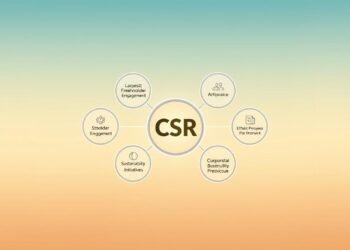Nonprofit organizations face big challenges to keep going and making a difference. They are key in solving social and environmental problems. In 2020, Americans gave $471 billion to charities, a 5.1% jump from the year before. This guide will cover what makes nonprofits sustainable and how to keep them going strong.
Money is a big worry for many nonprofits. Half of U.S. nonprofits have only a month’s worth of cash. It’s vital to plan finances well, find different ways to make money, and be open about money matters.
Volunteers are also key to a nonprofit’s success. Every year, 100 million people volunteer, adding $150 billion in value. Half of these volunteers give more money to the groups they help, showing how important it is to build strong supporter relationships.
To last long, nonprofits need to focus on leadership, talent, and technology. A good team can bring new ideas, work better, and attract more skilled people. This makes the organization stronger and more effective.
Key Takeaways
- Financial stability is key for nonprofits
- Volunteer support can lead to more donations
- Having different income sources helps nonprofits last longer
- Strong leadership and planning for the future are critical
- Investing in talent and tech improves work efficiency
- Keeping integrity builds trust with supporters
- Knowing how much programs cost and where money comes from is essential
Understanding Nonprofit Sustainability
Nonprofit sustainability is key for organizations wanting to make a lasting difference. It’s about balancing money with doing the right thing and connecting with the community. Sadly, 50% of U.S. nonprofits barely have enough cash to last a month.
Definition of Nonprofit Sustainability
Nonprofit sustainability means an organization can keep doing its mission over time. It’s about being financially sound, having strong leaders, and running effective programs. This way, nonprofits can keep helping their communities for many years.
Good nonprofits also find different ways to make money and keep volunteers coming back. This makes them strong and able to grow.
Importance of Sustainability in Nonprofits
Sustainability is essential for nonprofits to bring about real change. It helps them survive tough times and meet new challenges. Sustainable nonprofits can set long-term goals, not just survive day by day.
They’re also better at keeping good staff, with 67% of nonprofit CEOs looking to move up in five years. By focusing on sustainability, nonprofits can do more for their communities and make a bigger difference.
Key Components of Nonprofit Sustainability
Nonprofit sustainability is built on three main parts: financial stability, mission alignment, and operational effectiveness. These parts work together to help an organization succeed over time.
Financial Stability
A nonprofit’s financial health is key to its survival. It’s important to keep at least three months’ worth of expenses in cash reserves. This helps deal with unexpected issues and makes donors more confident.
Diversifying income sources also helps. This means not relying on just one source of money. One nonprofit grew from a few thousand dollars to over $70 million in just five years. They focused on financial stability and planning.
Mission Alignment
Nonprofits must make sure their programs meet community needs and their goals. It’s important to regularly check if programs are working well and if they’re financially stable. This means being ready to change and keeping a clear vision.
Being open to diversity and inclusion is also important. It helps nonprofits stay relevant and make a big impact.
Operational Effectiveness
Running efficiently is key for nonprofit success. This includes planning well, using technology, and managing volunteers well. Nonprofits should have plans for both short-term needs and long-term goals.
Using technology can make operations better and more efficient. Strong leadership and vision are also essential. They guide organizations toward lasting growth and impact.
Strategies for Financial Sustainability
Financial stability is vital for nonprofits to fulfill their missions. They must diversify income, master grant writing, and engage major donors. These steps help them make a lasting impact and handle economic ups and downs.
Diversifying Revenue Streams
Nonprofits need various income sources for stability. This includes grants, donations, earned income, and fundraising events. By having different income streams, they become more resilient. Looking for new funding all year helps keep cash flow steady and supports long-term plans.
Grant Writing Best Practices
Grant writing is a key skill for nonprofits. It involves finding the right opportunities, writing compelling proposals, and showing clear impact. Applying for grants throughout the year boosts financial health. Nonprofits should match their mission with funders’ goals for better success.
Engaging Major Donors
Strong donor relationships are key for lasting fundraising. Major donors offer significant support, making them critical to a nonprofit’s finances. Organizations should personalize communication, show real impacts, and involve donors in the mission. Using data analytics helps tailor strategies for better results.
By using these strategies, nonprofits can build a strong financial base. This lets them focus on their mission, make real changes, and ensure long-term success in a changing world.
Organizational Culture and Sustainability
A strong organizational culture is vital for sustainable nonprofits. It influences how teams collaborate and guides decisions. A positive work environment is essential for attracting and keeping skilled staff and volunteers.
Building a Strong Board of Directors
The board of directors is key to a nonprofit’s success. They set the direction and ensure ethics are upheld. Boards usually spend 25-35% of their budget on overhead costs.
Annual strategic planning is critical. It helps boards set goals and spot challenges ahead.
Volunteer Engagement Strategies
Volunteers are a big help for nonprofits. They give their time, skills, and sometimes money. To keep them engaged, clear communication and defined roles are important.
Regular updates and clear expectations help avoid conflicts and boost satisfaction. Digital tools, like board management systems, help manage volunteer efforts and planning.
Building a healthy culture is key to sustainability. It means treating employees fairly in pay, promotions, and job duties. A positive work environment lowers turnover, as bad culture is the main reason people leave.
By focusing on real leadership and clear communication, nonprofits can build a strong foundation for lasting success.
Measuring Impact and Success
Nonprofits have a tough time measuring their impact. With 75-80% of them making less than $500,000, they often lack the resources to evaluate well. But, showing their social responsibility through solid data is key to getting funding and staying afloat long-term.
Using Metrics to Assess Effectiveness
Measuring impact well means using both numbers and stories. Important metrics include how many people they help, how many goals are met, volunteer hours, and what programs cost. By tracking these, nonprofits can show how well they’re doing and their commitment to helping others.
Reporting and Transparency Techniques
Being open about their work builds trust with donors and the community. Nonprofits should share their data through annual reports, social media, and their website. This includes details on how much they spend on fundraising, admin, and programs. By being clear about their impact, they show they’re serious about making a difference and keep getting support.
Using new ways like storytelling and AI can help nonprofits measure their impact better. These methods help them show their value, even with limited resources. This way, they can stay strong in a tough market.
Building Community Partnerships
Nonprofits do best when they connect deeply with their communities. By forming partnerships, they can make a bigger difference. Let’s look at how nonprofits can build strong ties and bring about positive change.
Collaborating with Other Organizations
Working together with similar groups can help nonprofits reach more people. For instance, the North Texas Food Bank teamed up with UNT Dallas. Together, they gave out over a million pounds of food through a mobile pantry.
This kind of partnership boosts community involvement and tackles big local issues well.
Engaging the Local Community
Nonprofits can use local resources to make a bigger environmental impact. The American Studies Association gives grants up to $3,000 for community partnerships. This support helps nonprofits start projects that really speak to their neighborhoods.
HEB’s work with Communities In Schools of San Antonio for “Stuff the Bus” is a great example. It shows how businesses and nonprofits can work together to engage the community.
By focusing on teamwork and local ties, nonprofits can create lasting positive change. These partnerships not only increase their impact but also make sure they stay relevant and strong over time.
Leveraging Technology for Sustainability
Nonprofit organizations face big challenges in staying sustainable. Technology is key to solving these problems. A study shows 76% of nonprofits see tech’s value in their work. But, only a quarter have made real progress towards sustainability goals.
This gap shows the need for better tech use.
Digital Tools for Fundraising
Digital fundraising tools are changing the game for nonprofits. Online donations can jump by 30% with good email and social media campaigns. These tools help nonprofits reach more people and make giving easier.
Cloud-based solutions are affordable ways to update operations without big costs.
Using Social Media for Outreach
Social media is a strong tool for nonprofit outreach and building donor relationships. It lets organizations share their stories, connect with supporters, and build communities. By using social media, nonprofits can reach more people and connect with donors better.
This is key for long-term success, as it builds a loyal supporter base and raises awareness of the mission.
For nonprofits aiming for sustainability, using technology is essential. From digital fundraising tools to social media, tech offers many ways to improve operations, engage donors, and reach long-term goals. By embracing these technologies, nonprofits can boost their sustainability and make a bigger difference in their communities.
Sustainability in Program Development
Nonprofits have a big challenge. They need to balance helping society with keeping their finances stable. To do this, they must create programs that last and really help people.
Aligning Programs with Community Needs
Good nonprofits change their programs to fit what the community needs. This keeps their work relevant and helpful. They have a clear plan that includes their mission and how they will keep going.
By listening to local problems, they make programs that really help. This way, they serve their community well.
Evaluating Program Effectiveness
It’s key to measure how well programs work. Nonprofits should have clear goals and check their progress often. The Impact-Sustainability Matrix helps sort programs based on how well they fit the mission and last.
This tool helps decide which programs to focus on. It’s about choosing programs that are both important and can keep going.
As nonprofits grow, so does the money they make from their programs. But, as they get close to $2 million, the growth slows down. This shows the importance of getting money from different places, like grants and donations, to keep going strong.
Advocacy and Policy Engagement
Advocacy is key for nonprofits to stay strong. They use it to tackle big problems, shape policies, and make lasting changes. By spreading the word and getting people involved, they can tackle deep-seated issues and help communities grow stronger.
Role of Advocacy in Sustainability
Advocacy helps nonprofits protect their mission and grow stronger. They educate, build relationships, and join forces to push for policy changes. Working closely with the community is important, as it lets nonprofits amplify local voices and needs.
Good advocacy means understanding what the community needs and getting people involved. By working with the community, nonprofits can make sure their efforts really help. This approach leads to lasting growth and makes communities more resilient.
Building Relationships with Policymakers
It’s important for nonprofits to connect with policymakers. They need to know the difference between advocacy and lobbying. Advocacy is about promoting causes, while lobbying is about directly influencing laws. Nonprofits must follow the rules to keep their tax-exempt status.
Being ethical is critical when working with policymakers. Nonprofits should be open, honest, and respect the democratic process. By doing this, they can earn trust and credibility, making a bigger impact in their communities.
Challenges to Nonprofit Sustainability
Nonprofit organizations face many challenges on their path to lasting success. Economic ups and downs and changing social trends can hurt their work. These issues make it hard for them to keep doing their important missions.
Economic and Social Factors
Economic uncertainty is a big problem for nonprofits. In Canada, nonprofits added $176 billion to the economy in 2012, which is 8% of GDP. Yet, many struggle to stay financially stable. Social changes also make it tough for nonprofits to stay relevant and supported.
Competition for Resources
The nonprofit world is getting more crowded. Groups compete for donations, grants, and volunteers. In British Columbia, relying too much on one source is a major issue. This competition makes it hard for nonprofits to keep going and make a positive environmental impact.
To beat this, nonprofits need to find more funding sources and build stronger community ties.
Future Trends in Nonprofit Sustainability
Nonprofits are facing big challenges in 2024. Costs are going up, and the economy is changing. This leads to staff burnout. To stay strong, they need new ideas.
Sustainability in the Age of Technology
Technology is changing how nonprofits work. Generative AI helps with tasks and managing work. This lets staff focus on big goals.
Social media is also key. Nonprofits use it to reach different groups. They try new things like working with influencers or making podcasts. These tools help spread the word and gain support.
The Role of Social Enterprises
Social enterprises are growing fast. They mix business skills with doing good. Many nonprofits team up with companies to solve big problems.
This brings in money and new ideas. Some nonprofits even join forces. By working together, they can do more with less waste. Diversity and inclusion stay key in these partnerships.
Smart nonprofits use data to make choices. They stay flexible and work with others. Volunteer management is changing too. Good training helps keep helpers happy and reduces turnover.
Trust-based giving is on the rise, letting nonprofits try new things. To stay strong, groups need different ways to make money. Showing real results is key to keep donors giving.
Resources for Nonprofits
Nonprofits looking to grow can find many resources to help. Learning and growing are key to their success. Let’s look at some great tools and training options for nonprofits to do well.
Recommended Books and Journals
“Focus on Sustainability: A Nonprofit’s Journey” is a top book. It gives real advice for lasting success. The Stanford Social Innovation Review shares new research and examples of success.
These resources help nonprofits find new ways to make money. This could mean up to a 20% boost in yearly income.
Online Courses and Training
The internet is full of learning chances. The Foraker Nonprofit Sustainability Model has online courses for nonprofits. Many sites offer free or cheap webinars on things like working with donors and being more efficient.
Investing in staff and technology is key for 75% of successful nonprofits. This helps them stay strong.
Nonprofits can also use tools for checking their finances. The Nonprofit Cost Analysis Toolkit helps understand and improve finances. With these tools, nonprofits can make stronger partnerships and see up to a 30% better outcome in their programs.
FAQ
What is nonprofit sustainability?
Nonprofit sustainability means making choices that help an organization last long. It’s about being financially stable, planning for leadership, and making strategic plans. The Foraker Model sees sustainability as a journey with four parts: Focus, Right People, Partnerships, and Unrestricted Funds.
Why is sustainability important for nonprofits?
Sustainability is key for nonprofits to keep helping their communities. Many nonprofits struggle financially, with 50% having less than a month’s cash. Sustainable practices help them face challenges and keep their impact strong.
What are the key components of nonprofit sustainability?
Key parts include financial health, aligning with the mission, and being operationally effective. Values, community mapping, and strategic plans are also vital. Donor support and a strong online presence are important too.
How can nonprofits achieve financial sustainability?
Nonprofits can diversify income, understand their finances, and look for savings. They should explore new fundraising methods and keep a balanced fundraising approach. This helps them grow and stay financially stable.
What role do volunteers play in nonprofit sustainability?
Volunteers are essential for nonprofits. They often donate and help spread the word. Good volunteer management is key to using this resource well.
How can nonprofits measure their impact and success?
Nonprofits can track their success by setting metrics for program and organizational impact. The Foraker Model stresses the need to assess their journey. Being open about results builds trust with supporters.
What is the importance of community partnerships in nonprofit sustainability?
Partnerships are vital for nonprofits. They help find local assets and collaborators. Working with the community strengthens the organization’s impact and relevance. Partnerships can also share resources and improve efficiency.
How can technology contribute to nonprofit sustainability?
Technology boosts fundraising, donor engagement, and efficiency. A good website is key for sharing stories and collecting donations. Digital tools and social media help with outreach and measuring impact.
What challenges do nonprofits face in achieving sustainability?
Nonprofits face economic and social challenges, and competition for resources. They must stay focused on their mission and adapt to community needs. Ethical practices are also a constant challenge.
What are some future trends in nonprofit sustainability?
Trends include more tech use, social enterprises, and diversity focus. Nonprofits must adapt to these while keeping their core values and mission.




